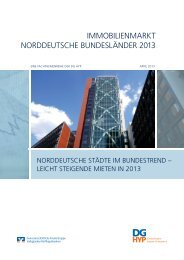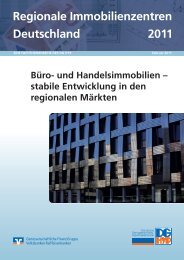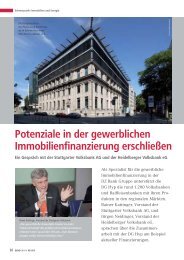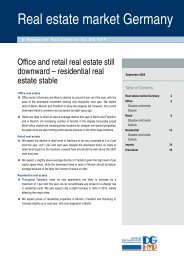ANNUAL REPORT 2006 - DG Hyp
ANNUAL REPORT 2006 - DG Hyp
ANNUAL REPORT 2006 - DG Hyp
You also want an ePaper? Increase the reach of your titles
YUMPU automatically turns print PDFs into web optimized ePapers that Google loves.
PROPORTION OF RESIDENTIAL REAL ESTATE<br />
OWNED IN THE EU<br />
Spain<br />
82 %<br />
Ireland<br />
75 %<br />
Italy<br />
71 %<br />
United Kingdom<br />
69 %<br />
Portugal<br />
66 %<br />
Finland<br />
64 %<br />
EU15 average<br />
59 %<br />
Sweden<br />
59 %<br />
France<br />
53 %<br />
Netherlands<br />
51 %<br />
Austria<br />
51 %<br />
Germany<br />
43 %<br />
Source: Eurostat<br />
DEVELOPMENT OF GERMANY’S AGE PYRAMID (1950–2050)<br />
More than ever, real estate markets need to be differentiated<br />
by region, as the emergence of prospering regions<br />
(as well as those suffering from structural weakness) put<br />
higher demands on the mobility of the work force. This has<br />
a direct effect on real estate markets. ‘Location’ as a<br />
criterion for purchases has thus gained in importance in<br />
several respects. At a macro level, preferred locations tend<br />
to be close to economic centres, whilst at a micro level,<br />
infrastructure and the immediate vicinity, together with<br />
shopping facilities and the social network remain important.<br />
As structurally weak, rural regions are becoming<br />
increasingly desolate – particularly in East Germany, but<br />
also in certain regions of the ‘old’ Federal Republic – there<br />
is continued demand for attractive housing in high-growth<br />
urban regions, such as Hamburg or Munich. Regional<br />
differences in real estate price developments reflect these<br />
trends.<br />
Against this background, residential real estate finance<br />
business in Germany is forecast to remain at a high level of<br />
between € 170 to 180 billion per annum. Given the stagnation<br />
in new construction activity, competitors are likely<br />
to focus on financing purchases or modernisation of properties.<br />
In this context, the emphasis will be on energy<br />
savings and changing environmental regulations, but also<br />
on higher expectations regarding housing standards and<br />
the specific needs of the fast-growing older generation<br />
group.<br />
50 years ago today in 50 years<br />
Age structure 1950 Age structure 2001 Age structure 2050<br />
100<br />
100<br />
100<br />
90<br />
90<br />
90<br />
80<br />
80<br />
80<br />
70<br />
70<br />
70<br />
60<br />
60<br />
60<br />
Men 50 Women Men 50 Women Men 50 Women<br />
40<br />
40<br />
40<br />
30<br />
30<br />
30<br />
20<br />
20<br />
20<br />
10<br />
10<br />
10<br />
0<br />
0<br />
0<br />
600 300<br />
300 600 600 300<br />
300 600 600 300<br />
300 600<br />
Figures in thousands<br />
Source: German Federal Statistical Office, 2005<br />
Deutsche Genossenschafts-<strong>Hyp</strong>othekenbank AG | Annual Report <strong>2006</strong><br />
5














